This article has multiple issues. Please help improve it or discuss these issues on the talk page. (Learn how and when to remove these messages)
|
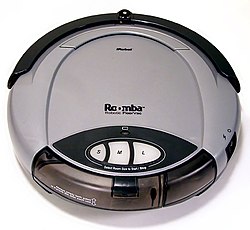 Original Roomba from 2002 Original Roomba from 2002 | |
| Type | Robotic vacuum cleaner |
|---|---|
| Inception | 17 September 2002; 22 years ago (17 September 2002) |
| Manufacturer | iRobot |
| Models made | See list |
| Website | https://www.irobot.com/en_US/roomba.html |
| Part of a series on |
| Automation |
|---|
| Automation in general |
| Robotics and robots |
| Impact of automation |
| Trade shows and awards |
Roomba is a term that refers to a series of autonomous robotic vacuum cleaners made by the company iRobot, and was first introduced in September 2002. Roombas have a set of sensors which help them navigate the floor area of a home. These sensors can detect the presence of obstacles and steep drops (e.g., to avoid falling down stairs).
As of 2024, iRobot markets models of their fourth through tenth generation, while continuing to provide support and to sell accessories for their previous series. Various models of the Roomba have different features, including tangle-free brushes, separate sweep canisters, more powerful vacuums, obstacle avoidance, and performance maps displayed via smartphone apps. Newer models also have a camera, which works in conjunction with onboard mapping and navigation software to systematically cover all floor areas, move from room to room, avoid obstacles such as pet waste and charging cables, and find recharging stations.
Roombas allow some modulation and reprogramming. Parts of some models are interchangeable, allowing owners to mix and match features or switch to other units for longer battery operation. Additionally, some units can be adapted to perform more creative tasks using an embedded computer in conjunction with the Roomba Open Interface.
In August 2022, Amazon announced its intention to purchase iRobot, though the acquisition was delayed by regulators in Europe for fear of hurting competition. As of January 2024, these plans were abandoned by Amazon.
Development
Engineer Joe Jones first conceived the idea for what eventually became the Roomba in 1989 while working at the MIT Computer Science and Artificial Intelligence Laboratory. The initial design, using Lego, stemmed from a design challenge between Jones and his colleagues. Early prototypes were created and presented to the Denning Mobile Robot Company and Bissell in the 1990s, but neither company was interested in producing them. The concept languished until 1999, when S.C. Johnson eventually agreed to fund the project at iRobot. The device was initially called "DustPuppy" before being renamed to Roomba. Development began in full in December 1999. S.C. Johnson pulled out after spending US$1–2 million, but iRobot continued with the project, eventually launching the first Roomba in September 2002.
Design

Roomba models are designed to be low enough to fit under beds or other furniture. Most Roomba models are disc-shaped, measuring 338–353 millimetres (13.3–13.9 in) in diameter and 86–94 millimetres (3.4–3.7 in) in height depending on the model. The S9 series robots are semicircular rather than circular, with a flat part at the front, and are narrower at 311 millimetres (12.2 in) wide. All models feature a large contact-sensing mechanical bumper on the front half, with a multi-directional infrared sensor located at the top front center. Most models also have a recessed handle located on the top.
The first and second-generation Roomba models utilized the Virtual Wall, a separately sold accessory that prevents it from entering an area. It projects a pattern of infrared light, which the vacuum detects and treats as a physical wall, prompting it to stop and turn around. However, third-generation and newer models have now been made compatible with the Dual Mode Virtual Wall, which, in addition to simulating a straight wall, can create a circular barrier roughly 4 feet (1.2 m) in diameter. Some 500, 700, and 800 series models are compatible with the Virtual Wall Lighthouse. It initially confines the vacuum to one area to be cleaned. Once the vacuum reports the area being sufficiently cleaned (based on its estimated area), it directs it to proceed to the next space to be cleaned and contains it there.
Roombas are driven by two independently operating side wheels, which can drive the Roomba forward and backward and change its trajectory. Rotary encoders on the wheels can detect the rate at which the wheels are spinning, determining if they are slipping or stuck. Drop sensors can detect if a wheel is too low, such as when it gets stuck in a vent. An undriven swivel caster is located at the front of most models and the back of the D-shaped S series. It is not used for steering, but it is used as an additional sensor. It has a rotary encoder as well. The caster's wheel is half black and half white, and optical sensors detect the change in color as it rotates. This helps detect if the Roomba is stuck or beached (i.e., the drive wheels are spinning, but the Roomba is not moving).
The cleaning head (brushes and suction area) on Roombas is relatively small. On most models, it is between the two side wheels and is around 5–8 inches (13–20 cm) wide; on the S series, it is moved to the flat square part of the D shape near the front, where it is wider, but still does not extend the full width of the vehicle. To compensate for this, Roombas have a rotating multi-pronged brush on one side that sweeps debris towards the path of the cleaning head, helping to clean a wider path and to reach into edges and corners.
A Roomba's bumper allows it to sense when it has bumped into an obstacle, after which it will reverse or change paths. Infrared "cliff sensors" on the bottom of the unit similarly prevent them from falling off ledges such as stairs. These may also trigger a false positive on dark or black-colored surfaces, such as some carpets, preventing Roombas from entering or cleaning those areas. Third-generation and newer models have additional forward-looking infrared sensors to detect obstacles. These sensors slow down the Roomba's speed when nearing obstacles to reduce its force of impact. It also cleans along walls without repeatedly bumping into them. This technology can also distinguish between hard and soft obstacles.
Most second- and third-generation models, as well as all newer ones, have internal acoustic-based dirt sensors that allow them to detect and focus on particularly dirty spots. Fourth-generation and newer models have an optical sensor located in front of the vacuum bin, allowing detection of wider and smaller messes.
Third-generation and newer models can reverse their brushes' rotation direction to escape entangled cords and tassels. If at any time the unit senses that it has become stuck, is unable to turn its main brushes, no longer senses the floor beneath it, or decides that it has worked its way into a narrow area from which it is unable to escape, it stops and sounds an error alert to help someone find it. Early models use only flashing lights or several beeps to indicate specific problems, while later models use a synthesized voice to announce a problem and a suggested solution. The voice is available in several languages. Models with app capabilities will also communicate the error to the app, which will notify the user via push notification.
Roombas are powered by a user-replaceable rechargeable battery; older models used NiMH batteries, while newer models use lithium-ion batteries, and a few models support both. First-generation models must be recharged from a wall power adapter and require the Roomba to be plugged in manually, while all subsequent models have a self-charging home base that the unit seeks out at the end of a cleaning session using infrared beacons. Charging takes about three hours. Battery reliability is a frequently mentioned complaint on customer review websites. Battery replacements from iRobot cost a significant fraction of the purchase price of a new Roomba, though compatible third-party batteries are available at a lower price. The iRobot customer support website offers advice on maximizing battery performance and longevity.
Operation
Control and cleaning

All Roomba models can be operated by manually carrying the Roomba to the room to be cleaned and pressing a button. Third-generation and later models can also be started directly from their charging bases. Later models introduced several additional operating modes, such as "Spot," which cleans an area of a few feet. Older Roombas had "Max" mode, which cleans endlessly until the battery is depleted; this was replaced by "Clean" on later models that had the ability to calculate room size. "Dock" mode, introduced with the third generation, instructs the Roomba to seek a charging base for recharging. The availability of the modes varies by model. Many second- and third-generation Roombas and certain newer models (such as the 880), come packaged with infrared remote controls or special control panels, allowing a human operator to "drive" the Roomba to areas to be specially cleaned.
Subsequent Roomba models can be controlled with the iRobot HOME app, where users can start and pause the Roomba, send it back to the charging base, choose time limits for it to run before returning home, and view details about each cleaning job, such as how long the Roomba ran for and how the job ended (i.e., being completed, canceled or the battery dying).
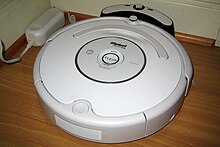
The cleaning time depends on room size and, for models equipped with dirt sensors, the volume of dirt. First-generation models must be told the room size, while subsequent models either estimate the room size by measuring the longest straight-line run they can perform without bumping into an object, or by creating a map of the room.
Non-desktop users can use the iRobot HOME App, although only certain models support 5 GHz. Wi-Fi connected Roombas can also connect to Alexa, Google Home, and other smart home platforms for voice control or use in automation.
Pathing
Starting with the eighth generation, Roombas have an upward-facing camera and a downward-facing infrared floor-tracking sensor, which are used to create a map of the floor. This enables them to use a back-and-forth cleaning pattern, which is faster and more efficient because it ensures more complete coverage without needing to cover an area multiple times. The floor-tracking sensor operates like an optical mouse and can provide precise movement data over small distances. However, this causes integration drift and small errors in measurement that accumulate over time. To rectify this, the upward-facing camera is used periodically to identify waypoints or "landmarks," coarse points that are used to correct the Roombas' position and map. Some algorithms, such as wall following, are still used, to partly assist in mapping the floor and to make sure the floor is cleaned along the edge and around obstacles. Unlike other mapping systems like lidar, which can operate in complete darkness, Roomba's camera requires some light in the room in order to be able to map it. Starting with the eighth generation, Roombas retain the map after each run and use subsequent runs to improve the map. Multiple maps can be stored, but users cannot edit maps to separate and label regions (such as rooms), which can't be used to have the Roomba clean only a selected room. Instead, most models come with one or more virtual wall barriers to help block off specified rooms
Roombas before the eighth generation models do not map out the rooms they are cleaning. Instead, iRobot developed a technology called iAdapt Responsive Cleaning Technology. This relies on a few simple algorithms, such as spiraling, room crossing, wall following, and random walk angle changing after bumping into an object or wall. This design is based on MIT researcher and iRobot CTO Rodney Brooks' philosophy that robots should be like insects, equipped with simple control mechanisms tuned to their environments. The result is that, although Roombas are effective at cleaning rooms, they take several times longer to do the job than a human would. Some users have used long-exposure photography or compositing to create images showing Roombas' coverage of the floor, and have even attached light sources to Roombas to create art using light painting.
Some have also noted that doubts about the effectiveness of the random algorithms have been reinforced by multiple reports of Roombas rolling over dog feces and spreading them through the room, which rather unpleasantly illustrates how well the Roomba can cover the floor's area. Roombas have become a common example of how randomized algorithms can routinely succeed even though they cannot absolutely guarantee success on any single run or even after many repeated runs. Compared to competing products available when Roombas were first introduced, such as the Electrolux Trilobite, the effectiveness of Roombas' random navigation was on par with (or even more effective than) robotic mapping technology available at the time, and cheaper to develop and produce, meaning it was sold at a significantly lower price.
When finished cleaning or when the battery is nearly depleted, Roombas (excluding first-generation models) will try to return to a base if one is detected. Roombas with mapping capability can recharge and resume a cleaning job, enabling them to clean large areas that take more than one full battery charge to complete. Roombas, except for first-generation models also support scheduling, allowing cleaning to start at a certain time and day of the week that the owner desires. Most 500-series models support scheduling through buttons on the unit itself, and higher-end models allow the use of a remote control, smartphone app, or smart-home automation integration to program schedules.
Maintenance
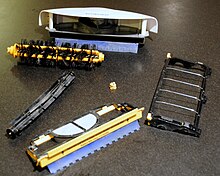
Roombas require regular cleaning and maintenance. Because they are smaller and less powerful than large upright vacuums, the dustbin must be emptied frequently, sometimes as often as every single use. Hair and other obstructions must be removed from rollers and brushes more frequently. Some reviewers have complained about this necessity compared to traditional upright vacuums that only need infrequent cleaning and almost no maintenance; however, others have countered that the chore is not difficult and that it takes significantly less time to clean a Roomba than it does to vacuum by hand.
iRobot has been praised for the availability of replacement parts for Roombas, with official parts still being sold for every model, including the first-generation Roombas almost 20 years after their release.
Models
As of 2022, there have been ten generations of Roomba units. All models have a patented design using pairs of brushes or rollers rotating in opposite directions to pick up debris from the floor. In some models, the brushes are followed by a squeegee vacuum, which directs the airflow through a narrow slit to increase its speed in order to collect fine dust. A horizontally mounted "side spinner" brush on the right side of the unit sweeps against walls to reach debris not accessible by the main brushes and vacuum. In the first generation, the dirty air passes through the fan before reaching the filter, while later models use a fan-bypass vacuum.
The early-generation models use a random algorithm from "bumping" to achieve total room coverage. A small vacuum empties into a removable dustbin, which has rotation brushes to aid collection. The robot is propelled by two knobby rubber wheels at the edges. It has several sensors, including a bumper that detects collisions and an infrared sensor on top to respond to a "virtual wall". The robot is powered by a rechargeable battery contained in the unit.
First generation: Original series
Introduced in September 2002, the first-generation Roomba had three buttons for room size. The first-generation units comprised the original silver-colored Roomba, the blue Roomba Pro, and the maroon Roomba Pro Elite. The latter two models included additional accessories, but all three used the same core robot and cleaning system
An original Roomba model robotic vacuum is in the collection of the National Museum of American History, which they note as the first successful domestic robot. The robot vacuum is described as being able to change direction when it encounters an obstacle or infrared beam and is powered by a battery.
Second generation: Discovery and 400 series
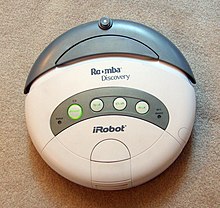
The second-generation Roombas ("Discovery," later called the 400 series) replaced their predecessors in July 2004. It featured a larger dust bin, improved software that calculates room size, dirt detection, and fast charging in the home base. Room size is detected automatically based on the longest straight-line path that can be driven. Instead of buttons for room size, their buttons are "Clean," "Spot," and "Max".
Roomba budget models (Dirt Dog and Model 401) used a simplified interface (a single "Clean" button) and lacked some of the software-controlled flexibility of other versions. They were less expensive models intended for first-time purchasers. The Roomba Dirt Dog contained sweeping brushes and a larger dust bin, but lacked the vacuum motor, using the space that would be required for the vacuum for additional dust bin volume. It was designed for a home shop or garage environment. The Roomba Model 401 was similar but had a standard-size dust bin and vacuum system. The Dirt Dog was discontinued in 2010.
Third generation: Professional and 500/600 series

The 500 series was introduced in August 2007 and featured a forward-looking infrared sensor to detect obstacles and reduce impact speed, a docking command button, improved mechanical components, smoother operation, and a modular design to facilitate part replacement. The Roombas' speed is also increased, which is possible in part because of the sensors to avoid bumping into obstacles too hard. It also introduced customizable decorative face plates. The Roomba 530 included two virtual walls and a charging dock. The 560 was one of the first Roombas to offer onboard scheduling and was also sold in a 562 Pet Series model with different brushes designed to clean up pet hair.
This model also included a newer version of the navigation software, now called iAdapt.
There are several types of dust and debris collection bins for the 500 series models. The standard vacuum bin incorporates a squeegee vacuum. The high-capacity sweeper bin does not include a vacuum, but has greater debris capacity. The AeroVac Bin directs suction airflow through the main brushes instead of using a squeegee, which is thought to keep the brushes cleaner.
The line was continued with the 600 series models, several of which had Wi-Fi enhancements. The 600 Professional Series robot was marketed towards small businesses. Several 600 series robots were praised for being budget friendly.
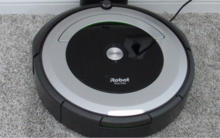
Fourth generation: 700 series

The 700 series, introduced in May 2011, though largely similar to the 500 and 600 series, included a more robust cleaning system, an improved AeroVac Bin with HEPA filter, and improved battery life. Like the 500 series, the 700 series had models with different technologies and accessories. The Roomba 760 was the simplest model, and the Roombas 780 and 790 were the most advanced, with both scheduling and a large range of accessories, including lighthouses, a wireless command center (also compatible with select retrofitted 500-series models), and extra brushes and filters. Besides these two models, Roomba 770 and 782e were available, with scheduling, dirt detection, and full bin indicator.
fifth generation: 800 series

The 800 series, introduced in 2013, is similar to the 700 series and its predecessors but contains updated technology. The AeroForce Performance Cleaning System, which is five times more powerful than the older series, and the iRobot XLife battery are some of the new features. The AeroForce system does away with the large rotating brush and pulls air between two rubber rollers, thereby getting the vacuum suction closer to the floor. The 805, released in 2013, was one of the earliest 800 models that utilizes the AeroForce cleaning system and has scheduling abilities, which allows up to 7 prescheduled runs per week, and comes with two virtual wall barriers. The 860 has an onboard HEPA filter and a more powerful motor and also contains a longer-lasting lithium-ion battery while the 870 and 880 have a NiMH (nickel–metal hydride) battery. In 2017, iRobot released the 890 with Wi-Fi connectivity that can be started with an app and various personal-assistant software.
sixth generation: 900 series

The Roomba 980 was released in September 2015 and contains a new visual simultaneous localization and mapping (vSLAM) navigation system, which allows it to clean an entire level of a home more efficiently. The 980 also features Wi-Fi connectivity and an iPhone and Android app. The Roomba 960 was released on August 4, 2016. As of March 29, 2017, 900 series users can receive detailed cleaning maps of their Roomba through the app. The maps show exact areas of clean and dirty spots in the home, allowing the Roomba to know where it needs to spend more time cleaning. However, the maps are not retained between cleaning runs, and each time the Roomba is run, it builds a new map from scratch. Push notifications of when the Roomba is finished cleaning are also a new feature. Integration to Amazon's Echo was also announced, launching in spring 2017.
Seventh generation: i series and e series


In September 2018, iRobot introduced a new Roomba series with three models: the premium i7 and the more basic e5. Each of these models also had a "plus" version that featured an automatic dirt disposal station that could be emptied. Similarly to the 900 series, the i7 uses vSLAM navigation. This feature retains the map after the Roomba has run, and uses subsequent runs to improve the map. This lets users select which room for Roomba to clean from the iRobot Home app. The i6 and i7 were criticised for being poor value.
In September 2020, iRobot released the i3, which is a lower-cost robot similar to the i7. The i3 does not use vSLAM navigation but relies on a downward optical encoder and gyroscopes; in addition, it doesn't allow selecting specific rooms, though this capability was added in 2022 with a firmware update in some regions. The i7 and i3 are compatible with the Clean Base, a base that empties the Roomba's bin into the Clean Base's internal disposable bag when it docks using a powerful vacuum. iRobot claims that the base can empty the Roomba's bin up to 30 cleaning cycles. The + in some models indicates that it includes the Clean Base. The i3 EVO model has upgraded firmware to include Smart Mapping functionality. The i3 received criticism for its poor navigation. The similar i4 and i5 robots, branded for European markets, were released in 2022. The i8+ was sold exclusively at Costco.
The basic e5 Roomba replaces the 800 series with an improved battery life of 60 to 90 minutes of run time on hardwood floors using a lithium-ion battery. It navigates in random patterns similar to the 6th generation and older robots. iRobot followed this with the similar e6 model. iRobot has also later released the i1 as a budget model through select retailers.
Eighth generation: s series
In late May 2019, iRobot introduced the Roomba s9 and s9+ as the "smartest, most powerful robot vacuum yet.". The S series features a newly designed "D" shape and corner brush for optimized edge cleaning deep into corners and along edges. Other new features include an anti-allergen system that traps 99% of pollen, mold, and allergens, 40 times the suction compared to the 600 series, 30% wider rubber brushes, and the most advanced navigation system to date. Similar to the I series, the s9+ comes with the self-emptying Clean Base. The S series also includes linking technology that allows the Roomba to communicate wirelessly with other iRobot products, where the Braava Jet M6 can automatically be set to mop after the s9 has finished vacuuming.
Ninth generation: j series
The j7 and j7+ models went on sale in September 2021 and debuted Precision Vision: the navigation system that detects and avoids obstacles like power cords and pet waste. The j7 is a direct upgrade to the Roomba i7, with the same overall body design and rated ten times the suction compared to the standard model. iRobot simultaneously removed the i7 from its website.
In September 2022, iRobot announced the Roomba Combo j7+, which is a Roomba j7+ that includes mopping capabilities with a lifting mop. Shipping began on October 4. iRobot has also released the j8+ which is a Costco exclusive variant of the j7+. On September 11, 2023, iRobot released the Roomba j9+, Combo j9+, and Combo j5. The Roomba j9+ offers 100% more suction compared to other j and i series Roombas. The Roomba Combo j9+ offers an entire new docking station with a water tank refill function added. Both j9+, Combo j9, and Combo j5 received new iRobot OS updates.
Other variants
iRobot has also released Roomba variants that do not fall into the traditional generation classifications. These variants typically have their own naming conventions, and/or have different architectures. The earliest known variant is the r1, released in 2021. The r1 contained two side brushes instead of one, one main roller instead of two, and a removable mop pad.
In April 2023, iRobot announced the Roomba Combo® Essential Robot, which also included a single main roller and a removable mop pad. This was later followed by the Roomba Vac Essential, which is the same robot without the mopping attachment.
Tenth Generation, Max Series
The new 10 max
Programming
See also: iRobot Create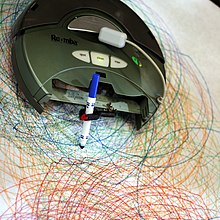
From the earliest models on, Roomba vacuum cleaning robots have been hacked to extend their functionality. The first adaptations were based on a microcontroller that was directly connected to the motor drivers and sensors. Versions manufactured after October 2005 contain an electronic and software interface that allows hackers to more easily control or modify behavior and remotely monitor its sensors. One early application was using the device to map a room. The native code for Roomba is written in a dialect of Lisp.
Models with an interface (400 series since October 2007 plus 500 and 700 series) come with a Mini-DIN connector supporting a serial interface, which is electrically and physically incompatible with standard PC/Mac serial ports and cables. However, third-party adapters are available to access the Roomba's computer via Bluetooth, USB, or RS-232 (PC/Mac serial). Roombas pre-October 2005 upgraded with the OSMO hacker device allow monitoring many sensors and modifying the unit's behavior. The Roomba Open Interface (OI, formerly Roomba Serial Command Interface) allows programmers and roboticists to create their own enhancements. Several projects are described on Roomba hacking sites.
In response to the growing interest of hackers in their product, the company developed the iRobot Create. In this model the vacuum cleaner motor is replaced by a "cargo bay" for mounting devices like TV cameras, lasers and other robotic parts. It provides a greatly enhanced 25-pin interface providing both analog and digital bidirectional communication with the hosted device allowing use as the mobile base for completely new robots. Together with a computing platform like a netbook or handheld device with wireless networking, it can be remotely controlled through a network.
See also
- Comparison of domestic robots
- Domestic robot
- Robotic vacuum cleaner
- List of vacuum cleaners
- Indoor positioning system
- Robotic mapping
- Robotics suite
- Scooba (brand)
- Braava
References
- "iRobot Corporation:Our History". Irobot.com. Archived from the original on 2012-01-03. Retrieved 2013-11-24.
- "Roomba Robot Vacuum Cleaners | iRobot®". irobot.com. Retrieved 1 August 2021.
- "Roomba Keeps Cleaning the Same Area (12 Reasons and 10 Fixes)". 2022-03-04. Retrieved 2023-05-03.
- Satariano, Adam (2024-01-29). "Amazon Scraps Deal to Buy Maker of Roomba Amid Regulatory Scrutiny". The New York Times. ISSN 0362-4331. Retrieved 2024-03-07.
- Rosen, Kenneth R. (2016-11-02). "Roomba's Long, Bumpy Path From Prototype to Your Living Room". The Vindicated. Retrieved 2024-03-07.
- Jones, Joe (5 May 2020). "Don't Fear the Robot". Nautilus. NautilusNext Inc. Retrieved 8 December 2023.
- Rosen, Kenneth (2 November 2016). "Roomba's Long, Bumpy Path From Prototype to Your Living Room". The Vindicated. Vox Media, LLC. Retrieved 8 December 2023.
- "iRobot Roomba 560 Video Review". Robot Reviews. Retrieved 18 September 2013.
- "DIY Virtual Wall for Roomba – Part One". misc.ws. 2014-02-07. Retrieved 2020-07-23.
- ^ Archived September 15, 2011, at the Wayback Machine
- "Find Answers | iRobot Customer Care". homesupport.irobot.com. Archived from the original on 2018-11-16. Retrieved 2018-12-06.
- "What are Roomba Virtual Walls?". iRobot Customer Care. iRobot. Archived from the original on 2018-11-16. Retrieved 2012-03-04.
- "iRobot: Customer Care - Roomba 500/600/700 Series Light Touch Technology". Homesupport.irobot.com. Archived from the original on January 26, 2013. Retrieved 2013-01-29.
- "What is Roomba's Dirt Detect technology?". Uksupport.irobot.com. Archived from the original on January 26, 2013. Retrieved 2013-01-29.
- "10 Ways to Keep Robot Vacuum from Getting Stuck under Furniture?". 2022-01-17. Retrieved 2023-05-03.
- "How can I prevent Roomba from getting stuck?". iRobot Customer Care. iRobot. Archived from the original on January 26, 2013. Retrieved 2012-03-04.
- "How Long Does It Take Roomba to Charge? | Live Lavish Life". 2022-01-29. Retrieved 2023-05-03.
- Stokes, Callum (2023-04-10). "How Long Does Roomba Take to Charge? A Brief Guide". House Vacuum Cleaner. Retrieved 2023-04-14.
- "Roomba 500/600/700 Series Battery Maintenance Tips". iRobot Customer Care. iRobot. Archived from the original on 2018-11-16. Retrieved 2012-03-04.
- "iRobot Roomba 880 review: a robotic vacuum cleaner that's almost a pet". TheGuardian.com. February 24, 2015.
- "What Devices are Supported by iRobot Home App?". iRobot. Archived from the original on 2020-06-03. Retrieved 2020-06-03.
- "Exclusive Wi-Fi Connected Robot Capabilities". iRobot. Archived from the original on 2020-06-03. Retrieved 2020-06-03.
- "What are the Wi-Fi Setup Requirements to Connect a Wi-Fi Connected Robot?". iRobot. Archived from the original on 2020-06-03. Retrieved 2020-06-03.
- "82 Alexa Roomba commands [2023]: The Complete List". Smart Geek Home. 11 November 2021. Retrieved 2023-01-11.
- ^ Evan Ackerman (2015-12-14). "Review: iRobot Roomba 980". IEEE Spectrum. Retrieved 2020-07-23.
- Bill Detwiler (2019-05-28). "Cracking Open the Roomba 980 robot vacuum". TechRepublic. Retrieved 2020-07-28.
- "iRobot Behavior Highlights" (PDF). 11 May 2013. Archived from the original (PDF) on 11 May 2013.
- "This is What Happens When You Put LEDs on a Roomba". 2013-04-10. Retrieved 2020-07-23.
- Leanna Garfield (2016-08-04). "Gorgeous light exposure photos capture the path Roomba takes while it vacuums a room". Business Insider. Retrieved 2020-07-23.
- E.D.W. Lynch (2011-07-01). "Light Painting With A Roomba". Retrieved 2020-07-23.
- David (2020-09-01). "Best Robot Vacuum 2021". Archived from the original on 2021-01-22. Retrieved 2021-01-18.
- Olivia Solon (2016-08-15). "Roomba creator responds to reports of 'poopocalypse': 'We see this a lot'". The Guardian. Retrieved 2020-07-23.
- "What's Behind the Success of iRobot's Roomba?". Robotics Business Review. 2010-01-30. Retrieved 2020-07-23.
- ^ Liam McCabe (2020-05-19). "The Best Robot Vacuums of 2020". Wirecutter. Retrieved 2020-07-23.
- "iRobot Store". iRobot. Archived from the original on 30 May 2015. Retrieved 30 May 2015.
- ^ "How do Roomba robot vacuum cleaners work?". 20 December 2009.
- ^ "Roomba Robot Vacuum Cleaner".
- "Official iRobot Website". Homesupport.irobot.com. Archived from the original on July 14, 2012. Retrieved 2009-06-09.
- Ackerman, Evan (May 17, 2010). "Review: iRobot Roomba 560".
- "Comparison of Roomba 500 Series Robots | Robot Reviews". www.robotreviews.com. Retrieved 2024-04-08.
- Broida, Rick. "Review: iRobot Roomba Pet Series 562". Wired. ISSN 1059-1028. Retrieved 2024-04-08.
- Denby, Laura. "Roomba 694 Review: The Best Roomba For Daily Maintenance". Forbes. Retrieved 2024-04-16.
- "iRobot Introduces Roomba Pet And Professional Vacuum Cleaning Robots".
- Charlton, Alistair (2017-11-27). "iRobot Roomba 616 review: iRobot Roomba 616 review: There's nothing wrong with buying the cheapest". gearbrain.com. Retrieved 2024-04-08.
- Florence Ion (2017-10-19). "iRobot Roomba 650 Review: A Good Value". Tom's Guide. Retrieved 2024-04-08.
- "iRobot Corporation: Roomba 790". Irobot.com. Archived from the original on 1 July 2012. Retrieved 1 July 2012.
- "Bobsweep vs Roomba vs Neato – Robotic Vacuum Cleaners Battle!". Sevenhints. 2017-03-14.
- "Roomba 805 Robot Vacuum Review". RoboAuthority.com. 2022-01-26. Retrieved 2023-05-03.
- Kevin (2016-07-28). "Roomba 860 Review - High Quality Vacuum without Fancy Navigation Tech". Smart Robotic Home. Retrieved 2023-05-03.
- "Roomba 860 vs 880: How Different are These Two Robot Vacuums?". bestcordlessvacuumguide.com. 6 February 2017. Retrieved 2023-05-03.
- "iRobot Extends Wi-Fi Connectivity with New Roomba 890 and 690 Vacuuming Robots". iRobot MediaKit.
- Wollerton, Megan. "iRobot Roomba 980 review: You'll pay a premium for this smart but unexceptional vacuum bot". CNET. Retrieved 2023-02-28.
- "Roomba Robot Vacuum | iRobot". irobot.com. Archived from the original on 2019-02-15. Retrieved 2019-02-14.
- "iRobot Roomba 960 Review". PCMAG. Retrieved 2023-02-28.
- "Roomba 960 vs. 980 — Side-by-Side Comparison". Modern Castle. 16 December 2022. Retrieved 2023-02-28.
- "iRobot Releases Roomba 960 Robot Vacuum | iRobot". iRobot MediaKit. Retrieved 2020-03-31.
- McFarland, Matt (2017-03-15). "Roomba will now tell you what part of your home is dirtiest". CNNMoney. Retrieved 2017-03-29.
- Vincent, James (2018-09-06). "iRobot's latest Roomba remembers your home's layout and empties itself". The Verge. Retrieved 2018-12-22.
- Kennedy, Swartzcop (2021-03-27). "Roomba i6 vs i7 Comparison Review - Is There a Better Option?". RobotBox.NET. Retrieved 2023-02-28.
- Chan, Jonathan (November 16, 2020). "This Roomba cleans like a pro, but it lacks the value of other models". Reviewed. Retrieved 2023-02-28.
- "Full Page Reload". IEEE Spectrum: Technology, Engineering, and Science News. 21 September 2020.
- "Roomba® i Series | iRobot". irobot.com. Archived from the original on 2020-10-26. Retrieved 2020-10-23.
- "iRobot Roomba i7+ review". digitaltrends.com. 26 September 2018. Retrieved 2019-02-06.
- "iRobot Roomba i3+ EVO Full Review - Life on AI". lifeonai.com. Retrieved 2023-02-28.
- Harrison, Richard (2021-07-28). "Roomba i3 vs. i4 Face-to-Face Comparison Review". RobotBox.NET. Retrieved 2023-02-28.
- "This Lower-Cost Roomba Needs Some Navigation Help". WIRED. Retrieved 2023-02-28.
- Allcock, Polly (16 May 2022). "Roomba i5 and i5+ robot vacuums with self-emptying dustbin option launch in Europe". Notebookcheck. Retrieved 2023-02-28.
- "iRobot Roomba i8+ Review". RTINGS.com. Retrieved 2023-02-28.
- "iRobot Roomba e5 review: Superb and affordable". Digital Trends. 2022-02-17. Retrieved 2023-02-28.
- "Roomba e5 details". 7 December 2019.
- "Roomba e5 Review - Is This the Best Entry-Level Robot?". Smart Robotic Home. 9 June 2019.
- "Roomba e6 Review". Modern Castle. 16 December 2022. Retrieved 2023-02-28.
- "Roomba i1 vs i3 – Is There Even a Difference?". Smart Robotic Home. 2022-05-12. Retrieved 2023-03-01.
- ^ "Roomba s Series | iRobot". irobot.com. Retrieved 2019-06-10.
- "iRobot Rooma j7 Robot Vacuum (7150)". irobot.com. Retrieved 2021-09-11.
- "Roomba Combo™ j7+ Robot Vacuum and Mop". irobot.com. Retrieved 2022-09-27.
- Kat (2023-01-30). "Roomba j7+ vs j8+: Is There Even a Difference?". Smart Robotic Home. Retrieved 2023-05-03.
- "iRobot® Roomba® Combo r1138". store.irobot.ch (in German). Retrieved 2023-03-01.
- "iRobot Roomba Combo r1". digitec.ch. 2023-02-28.
- "Roomba Combo® Essential Robot | iRobot". www.irobot.com. Retrieved 2024-04-08.
- "Discussing and Dissecting the Roomba 780 ad Scooba 230". Roomba Community. Retrieved 2012-03-04.
- "iRobot Roomba Serial Command Interface (SCI) Specification" (PDF). Irobot.com. Archived from the original (PDF) on 2013-12-02. Retrieved 2013-11-24.
- Gerkey, Brian (2006-03-31). "Robotic mapping for Roomba". Artificial Intelligence Center. SRI International. Retrieved 2013-06-13.
- "Introduction: Why Lisp?". gigamonkeys.com.
- "Roomba Development Tools". Archived from the original on 2006-07-11. Retrieved February 1, 2007.
- "OSMO - RoombaDevTools.com". 2007-01-15. Archived from the original on January 15, 2007. Retrieved 2013-11-25.
- "iRobot Corporation: Roomba Open Interface" (PDF). iRobot. 2006. Archived from the original (PDF) on 2015-02-18. Retrieved 2015-09-07.
- "Roomba hacking projects". Hackingroomba.com. Retrieved February 6, 2013.
- "Roomba Robot project". Irobot.com. Archived from the original on 2016-01-07. Retrieved 2012-03-04.
External links
- iRobot.com, manufacturer and retailer of Roomba in the United States
- Don't Fear the Robot – description of the invention process, with prototype photos
| iRobot | |
|---|---|
| Current | |
| Former and discontinued | |
Categories: